This week, I talk about spirituality in art and claim that you also need humor and playfulness to become a spiritual artist.
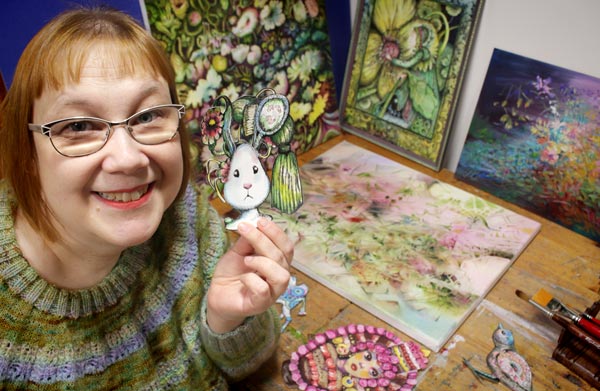
I like to gather my work – big and small – together and mix and match them like they would be pieces in a puzzle. It also helps me to see if my classes support each other and ponder if I have approached imagination and art-making from all angles.
Paul Klee and The Power of a Child
My newest class Floral Freedom is the most schoollike of all. It is based on Paul Klee’s and Wassily Kandinsky’s teachings of abstract art. In the class, I have tried to focus on two books – Paul Klee’s Pedagogical Sketchbook and Wassily Kandinsky’s book Point and Line to Plane. But the books’ teachings have inspired me to search for background stories – find what enabled these artists to invent the abstract methods and theories.
One of the things that needed an explanation was that Paul Klee’s book is full of diagrams like it would be written by an engineer, and yet, his artworks are often playful, some even childish. Look at this painting, for example!
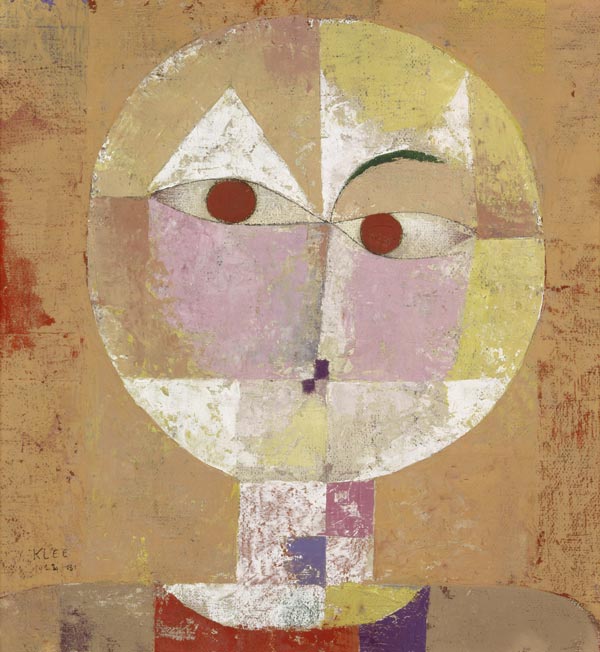
During the first world war, Paul wasn’t a soldier for a long time but transferred to a safer job where he was in the middle of aircraft engineers. But earlier, when he started a family, Paul wasn’t very successful in art at all. His wife worked to support them, and Paul practically took care of their only child, Felix. It wasn’t usual to be a stay-at-home dad in the early 20th century!
When Paul was taking care of Felix and struggled with art-making, he found humor and playfulness that later became a part of his signature style. But it’s not only that! When Paul became close friends with the masterful Wassily Kandinsky, he also made Wassily less serious and more playful. So here’s to all stay-at-home dads and mums!
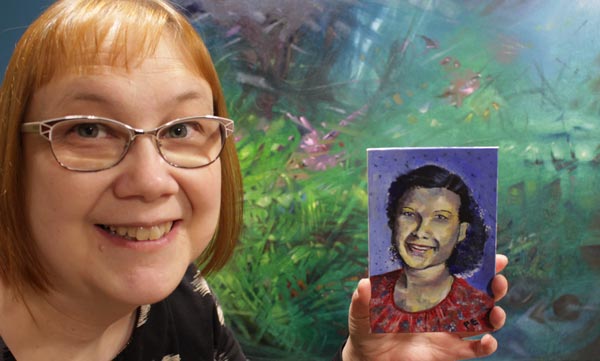
There’s a recent finished painting in the background.
From Product Play to Spirituality
I believe that art happens when one extreme meets another. When my organized mind watches the snowstorm. When I want my art to be about happiness and life and realize that taking it deeper requires confronting fear and death.
In my experience, when you want your art to be more serious and spiritual, humor and playfulness must have some role too. And vice versa, the longer your walk in the path of play, the more serious and spiritual it gets.
When I started my blog over ten years ago, my art-making was very product-based. I bought new supplies almost weekly and experimented with all kinds of techniques and effects.
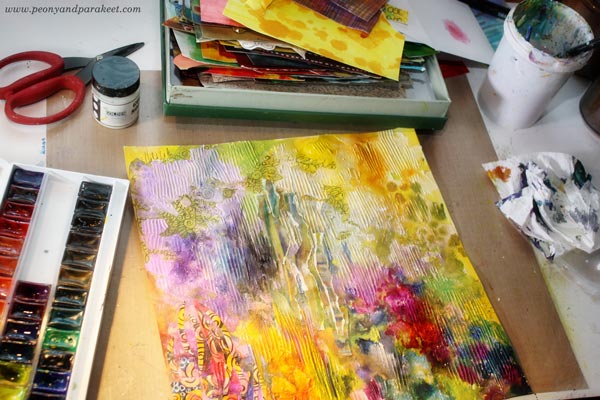
But the more I created, the more I wanted to move from materials to ideas and imagination. Instead of discovering ten new ways to produce circles on paper, I wanted to learn how to make the circles interact and transform into other shapes. This way, my art has gradually become not only more playful but more spiritual as well.
Paul Klee said:
“Art does not reproduce what we see; rather, it makes us see.”
Rethinking Spirituality in Art
Nowadays, I connect playfulness with spirituality. It has also made me rethink how I approach spirituality in general. Here’s what I wrote this week on Peony and Parakeet’s Facebook page and on my Instagram feed:
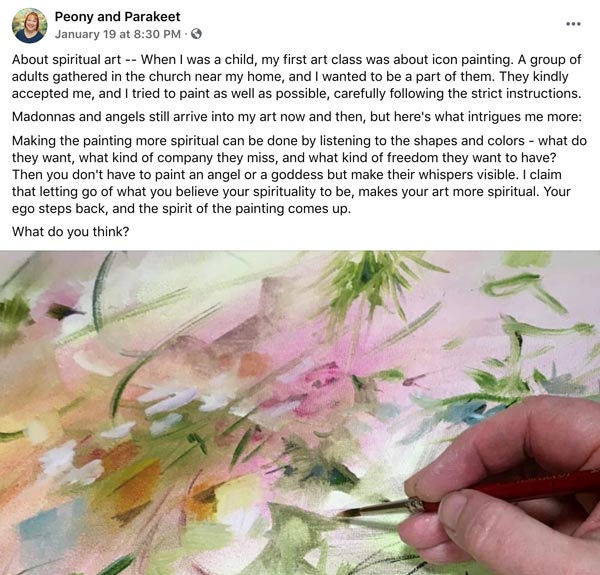
It would be interesting to hear what do you think. Does spirituality have a role in your art?

For me, I always ask God to enable me to not fear and just paint what I feel. I love to watch others painting online. It has really taught me a lot. Really more than in college because instructors want you to paint ONLY the way they interpret it. Paivi, you encourage free expression. That’s what I love about you.
Thank you, Phyllis! “To ask not to fear” – I love that, it’s such a boost in self-confidence, especially when doing regularly. Wonderful to hear that you like the results from Floral Freedom!
I agree Pavi that play is important to spiritual expression. Getting out of my own way is the key. Bring big arm and media movements results in more magical shapes and liveliness that thrills me more. Out of these shapes and spaces I see something I never thought about before. I am becoming more brave to explore different ways of expressing. I am also surprised at how much I like what I have been doing in Floral Freedom work shop.
Thanks, Ann! I agree, colors and shapes don’t always have to be born intentionally, sometimes art is the art of seeing and receiving!
I am not an artist, but a wanna be artist. I’ve collect how-to books, materials, some of which I have no idea what I thought I’d use them for…but here’s the thing. I am becoming more and more aware of the idea of spirituality, of letting go of ego, breathing deeply, seeing what happens if…I take lots of risks with my writing, and now want to play with art. I really appreciate your connection of the two. Thanks.
Oh, my heart jumped with joy – there’s a writer who reads my blog and who dreams about creating art!
There’s a lot in writing that you can use for visual expression, so I am excited for you! But as you know that it’s quite impossible to learn writing without writing, it’s even more impossible to learn painting or drawing without doing it. With writing, we can just type, but with painting and drawing, motoric skills need to grow too.
I also think that we have to move a part of the wisdom from our brain to our hand, and also accept that the hand accidentally creates something that’s more interesting to the mind than the image that has been growing there for weeks. That’s when the adventure begins!
I consider all my art and poetry to be an expression of the spirit of me, however that manifests, in the process of creating. I had a loose Catholic upbringing. I say loose because we lived in a wilderness area of Aotearoa New Zealand until I was nine and had no car for most of that time. My father was an atheist but when I asked him why he didn’t go to mass he said when he wanted to talk to God he would sit under a tree. Then he winked. I don’t belong to any religion now but follow a Buddhist philosophy in my daily life. I have an aversion to dogma, not liking to be controlled by outside forces and thinking and I attempt not to believe anything. I would prefer to be in my not knowing than to take on a belief system.
I agree playfulness, curiosity and open mindedness are useful assets in creating and walking, what I call, a Wildflower Path.
I love this “prefer to be in my not-knowing” It feels to me that this kind of approach leaves room for the spirit to come up!
Letting go of mind, allowing my playful spirit to take over, and create! Difficult for me as an engineer. As a former A type personality for self, I still carry control into my art. I want to adopt your free spirit side and have fun making marks. I need spiritual creative fun in my life now. This is what I see in your work and love it.
Thank you, Annie! However, don’t left your inner engineer too behind! There’s a lot in art that looks effortless but is very analytical and full of attention to nuances, that applies to my art too. I use my inner engineer all the time even if the ultimate experience for me in art is freedom. So it’s just great to be an engineer too!!
Hi Päivi! The painting of your mom and your colorful, playful painting from 2014 are both wonderful. The intensity of the yellow in the 2014 one is glorious, and the emerging flowers give a feeling of lushness. I agree that it’s important for the ego to step back. Nothing dampens my creativity and playfulness more than concerns about my own skill or importance.
Thank you, Melinda!!